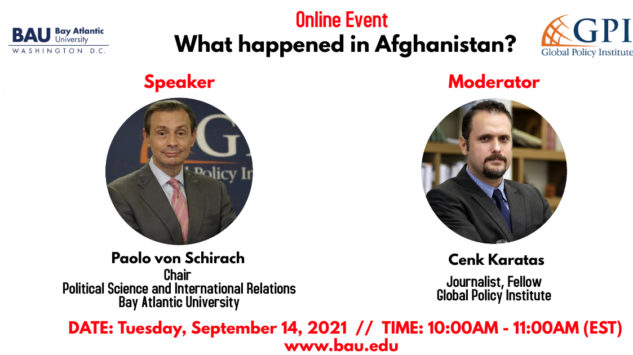Events

Event Summary // What happened in Afghanistan?
Speaker
Paolo von Schirach, President Global Policy Institute and Chair, Political Science and International relations, Bay Atlantic University
Paolo von Schirach research and teaching focus on international security, world affairs, international economics, competition policies, and industrial innovation. Von Schirach is the Editor of the Schirach Report, an online publication focusing on politics, economics and international security. He is a commentator for radio and TV on US foreign and domestic politics. He holds BA and MA degrees in Political Science from the University of Pisa, (Italy), and an MA in Government (International Relations) from Georgetown University where he was also a Fulbright Scholar and a Fellow in the Government Department. He was a Research Associate at the Center for Strategic and International Studies, CSIS. Later on, he served as Director of Communications and as Senior Research Fellow at the Atlantic Council. He worked as Deputy Director of the Global Security Project at Georgetown University where he also taught in the Graduate Program of the School of Foreign Service, (MSFS). He has been a frequent lecturer at the Foreign Service Institute, (FSI), a higher education institution part of the US Department of State. An experienced trade and investment promotion expert, for over 25 years Paolo von Schirach was Team Leader and Chief of Party in South East Asia and sub-Saharan Africa for consultancies which designed, executed and evaluated private sector development strategies and projects on behalf of the United Nations Development Programme, (UNDP); The World Bank; The African Development Bank, (AfDB); The United States Agency for International Development, (USAID); The European Union Commission; Business Climate, (BizClim, Brussels); the Government of Finland; and the German Technical Cooperation Agency, (GTZ).
Moderator
Professor Cenk Karatas, Bay Atlantic University, Journalist, and Fellow at the Global Policy Institute
Cenk Karatas is an adjunct professor of Communication and Politics at Bay Atlantic University. He is a journalist and a senior analyst on Turkish affairs with a background in Turkish and international media. He holds an MA in International Relations and a BA in Advertising with an emphasis on Journalism and Media from Bahcesehir University in Istanbul.
Event Summary
The conversation on the complex 20 year history of America’s deep involvement in Afghanistan began with a description of the policy decisions that followed the 9/11 2001 attacks on the US homeland. American policy-makers attacked and invaded Afghanistan because US intelligence knew that this faraway, desolate country hosted the leadership and the training facilities of Al Qaeda, the terror group that had organized, directed and executed the 9/11 attacks. The Taliban regime became a target not because they were involved with 9/11 but because they were the willing hosts of Osama bin Laden and his al Qaeda cohorts, the masterminds of the terror attacks. The military operation was low cost and swift. It was however only a partial success. The Taliban regime was removed from power and the Al Qaeda training camps and other facilities were destroyed. But bin Laden managed to escape, while many Taliban leaders took refuge across the border in Pakistan. At that point, the US and its NATO Allies that participated in the Afghanistan operation decided that it would be a good idea to modernize Afghanistan by introducing a democratic government, while encouraging economic development. The goal was to “immunize” Afghanistan against the disease of Islamic radicalism. A noble goal, no doubt; but essentially “mission impossible” given the complexities of an extremely poor, underdeveloped, tribal society that never knew western style democracy. The ensuing 20 years saw only modest progress, at an enormous cost now estimated to have exceeded two trillion dollars, in the implementation of this extremely ambitious agenda. The major failure was in the American inability to root out massive corruption. In fact, the entire US-led aid program fueled corruption at all levels. Corruption in turn undermined the notion that a modern western style government would help the development of the Afghan society. Indeed, endemic corruption fueled distrust and allowed the Taliban to slowly come back, with some degree of support, especially in the rural areas. As the Taliban slowly gained ground over the years, the US continued its fruitless (it turned out later) effort to train and arm the Afghan army. In the end the US decision to pull out was driven essentially by exhaustion. While much can be criticized about the hasty and messy US withdrawal, it is clear to all that the Kabul government supported by America was just a castle of card. Because of corruption and lack of real leadership, as soon as America declared its intention to remove the small number of remaining US troops, the whole edifice crumbled, in no time. In the end, the Taliban took control of Kabul without firing a single shot. The Afghan regular forces had simply run away, leaving behind expensive military equipment supplied by Washington. The lesson to be learned here is that grandiose goals about transforming backward countries will fail, because most of the time those societies are not ready for major changes. America tried for 20 years in Afghanistan and failed, miserably. Hopefully the same mistake will not be made in the future.